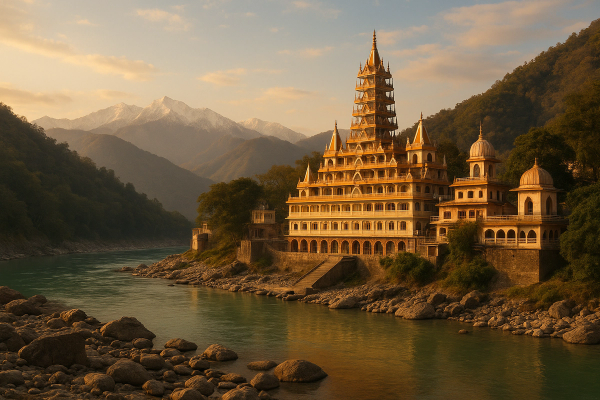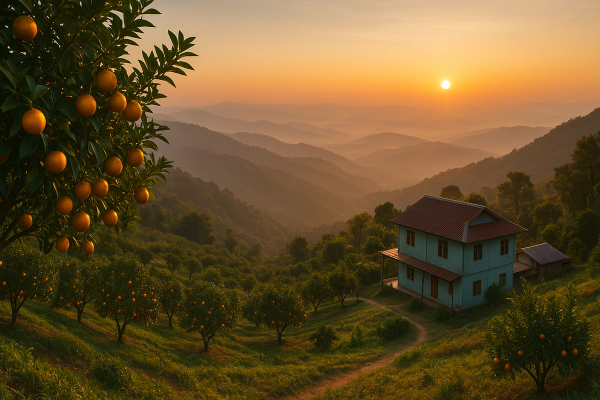Himachal’s Hidden Valleys: Tirthan & Unexplored Gems — a trip that felt like a secret shared#
I didn’t plan to fall in love with Tirthan. Honestly, I thought it would be “nice” and quiet and I’d get some mountain air and all that. But the river, the cedar smell, the way evenings go silver-blue after 5 pm. It got under my skin. Tirthan is that friend who doesn’t talk too much but shows up with warm chai when you need it.¶
Getting there the desi way — buses, shared cabs, and one bumpy shortcut#
If you’re coming from Delhi or Chandigarh, the easiest hack is still those overnight Volvos to Manali. Get off at Aut tunnel. From Aut, grab a local HRTC bus or a shared cab to Banjar, Jibhi, or Gushaini. Cheap, cheerful, slightly chaotic. I paid around 250–400 for the last leg in a shared taxi, depending on my bargaining mood. Driving yourself? Route is Delhi–Chandigarh–Bilaspur–Mandi–Aut–Banjar. Road’s fine most of the year, but during heavy monsoon it gets gnarly with landslides. Check HPTDC or HRTC updates before you roll. Jalori Pass sometimes shuts after fresh snowfall in deep winter, so keep plan B. As of early 2025, buses are running regular, but weather can flip in an hour up there, so don’t be shy to ask locals.¶
First feel of the valley — Gushaini mornings and that river hush#
Gushaini was my base for a bit. The river is right there, singing like a cousin who can’t keep quiet at a wedding. Early mornings, a dog snores under the deodar, smoke from someone’s kitchen rises, and you hear the faint thak-thak of roti. I went for a lazy walk to Chhoie waterfall, got lost on a goat trail, and a kind uncle sent me back with directions and two walnuts. Typical pahadi hospitality. You’ll realise pretty fast here that time moves on mountain speed, which is slower and somehow kinder.¶
Where to stay — homestays by the river or snug wood cottages#
Tirthan and the Banjar side have gone from hush-hush to mildly trendy, but thank god not overbuilt like some other hill towns. You’ll find solid homestays in Gushaini, Nagini, and Ropa starting around 1200–2500 a night with meals. Boutique riverside stays and wood cottages are in the 3500–7000 bracket, and yes, some fancy ones go higher on weekends. Jibhi is busier with cafes and Wi‑Fi, while the inner Tirthan villages feel more old-world. For workations, a bunch of stays advertise 20–50 Mbps internet, but be ready for occassional power cuts. Carry a Jio and an Airtel SIM both. ATM is at Banjar, not every village, so carry cash. And book on weekdays if you can — cheaper, quieter, cuter.¶
GHNP: The Great Himalayan National Park — Rolla trail and quiet kindness#
The gateway to GHNP is the real magic. It’s a UNESCO site, insanely rich in biodiversity, and super strict on plastic. I did the Rolla day trail which starts not far from Gushaini, and wow. Dappled light, hanging moss, the Tirthan river flashing between trees. For deeper treks like Shilt Hut or Rakhundi, talk to local guides in Sai Ropa or Gushaini. Permits are a must for core treks, and camping is regulated. They’ll sort tents, food, and the boring-but-important paperwork. It’s not the cheapest, but totally worth it. The forest is alive in a way city folks like me and him forget exist.¶
Trout, siddu, and pahadi chai — fuel for wander legs#
Everyone talks about trout here and fair enough. The grilled trout with a little nimbu and salt hits different in the cold. But don’t miss Himachali soul food. Siddu, steamed and stuffed, dunked into ghee and eaten with dal. Madra that’s creamy and tangy, rajma that tastes like it went to a gurukul to learn patience. If you’re lucky to catch a dham feast during a local function, skip all cafe food and eat with your hands on pattals. Jibhi still has the usual cafe suspects — momos, thukpa, pancakes, avocado toast for the workation crowd — but the real comfort is chai at a dhaba after a windy ride to Jalori.¶
Jalori Pass, Raghupur Fort meadows, and Serolsar Lake — the perfect day#
Jalori Pass looks unreal when the sky goes crisp blue. I hit it on a clear morning, wind trying to steal my cap, and did the Raghupur Fort meadow loop. It’s not a fort-fort, more like ruins and this wide meadow that makes you want to lie down and watch clouds drift. Serolsar Lake on the other side is a gentle walk too, with a little temple and water so still you’ll feel rude breathing loudly. If it snows, the pass can shut, so don’t risk it without fresh local info. Also, decent shoes, yaar. I saw someone in city sneakers doing ice-ballet unintentionally.¶
Unexplored gems that quietly glow#
Okay, here’s the fun bit. Tirthan has siblings. The next valley over, Sainj, is softer and more old-school, and Shangarh meadow is just… wow. Wooden temples, a meadow like a green quilt, sunsets that make you talk less. Closer to Tirthan, hit Sharchi village and the trail towards Lambri Top for big views without big crowds. Chehni Kothi near Jibhi is a tall wooden tower that looks straight out of folklore. Pekhri and Bahu are slowed-down hamlets where life feels hand-stitched. Gadagushaini is another lovely detour if you like roads that make you say a small prayer and then laugh at yourself.¶
Btw, permits, fishing, and little rules that matter#
Himachal has a strict plastic ban. Please carry a bottle and refill. Fishing in the Tirthan is regulated — get a permit from the fisheries office near Sai Ropa or Banjar, fees vary by stretch and season, and catch-and-release is encouraged. GHNP doesn’t allow loud music or litter, and camping is only in designated zones with permissions. Local deities are deeply respected here, so dress modest near temples and don’t touch the palanquin if a devta procession passes. It’s their living culture, not a photo prop, you know.¶
What it costs to do it right#
Ballpark budgets per person per day if you mix it smart. A decent homestay with meals will land you around 1800–3000. Cafe days in Jibhi might push it to 3500 if you go cappuccino-crazy. Guided day hikes in GHNP range depending on route and group size. Shared cabs are 200–500 between hubs, autos barely exist, and local buses are your best budget friend. If you want a boutique riverside wooden cottage with views that heal your childhood trauma, think 5000–9000 on weekends. Off season deals are real, ask directly on WhatsApp, people respond fast.¶
When to go — seasons that actually change the story#
Spring, March to May, is fresh and floral. River high, skies clean. Summer is lush and families show up, still okay if you pick quieter villages. Monsoon, July to August, is green-dream but landslides and road blocks are a thing, so move with caution and buffers. Post-monsoon September to November is my fav — sharp views, apple season, golden afternoons. Winter is hush and beautiful, Jalori often snows, and nights bite. Book places with heaters or bukhari, and don’t underestimate the cold even if you’re feeling brave in that one puffer jacket you bought on sale.¶
Network, workation reality, and the cafe scene that found the hills#
Jibhi’s now a mini workation hub. You’ll find cafes with Wi‑Fi, menus in cursive chalk, and folks on Zoom calls while maggi steams. It’s cute but not flawless. Power cuts happen. Networks dip at random corners. Tirthan side is calmer and more patchy. If you have a deliverable, sit closer to Banjar or pick a stay that mentions dedicated broadband and has an inverter. Also, please don’t hog tables for hours after buying one coffee if the place is small. I know we all do it sometimes, but still.¶
Safety, weather quirks, and being a decent traveller#
Himachal had rough monsoons recently, so listen to locals about road closures. Don’t push late-night driving on mountain roads if you don’t have to. River looks friendly but currents are strong — keep distance, especially in rains. Solo women travellers I met felt safe, as did I, but regular common sense applies. Keep an offline map and tell your host your day plan if heading into forest trails. Oh and pack a basic med kit. At altitude your body does silly things like pretending it’s fine and then it’s not.¶
A day that stayed with me — Sainj and Shangarh#
I took a slow bus to Sainj, grabbed a thali in a tiny dhaba where the aunty kept piling more ghee. Shangarh meadow opened up like a sigh. Kids playing cricket, temple bells drifting, a grandpa sunning himself on the steps. No crazy crowd, no loud speakers, just a lazy sun. I sat there doing nothing for an hour and somehow that became the highlight of the week. Sometimes the itinerary is the problem, not the place.¶
Tiny mistakes I made so you don’t have to#
- Packed only sneakers. Carry one proper trekking shoe and chappals for the homestay
- Didn’t keep cash. ATMs aren’t everywhere and UPI can sulk when network drops
- No buffer day. Mountain weather will laugh at your tight schedule
- Forgot a light rain jacket. Even in so‑called dry months a sudden drizzle is normal
Local culture notes — what I loved#
Temple woodwork is gorgeous. People are soft-spoken but sharp-witted. There’s an easy rhythm to life here, and it rubbed off on me. If a devta yatra passes, step aside respectfully. If a homestay family invites you for chai in the kitchen, go. Say thank you with small gifts from your city or just good manners. You’ll recieve much more than you think just by showing up right.¶
Quick add-ons if you’ve got extra days#
If you’ve done Tirthan and Jibhi, loop to Shoja for sunsets, or drive further towards Jalori and stay a night in a small lodge for those early hikes. Explore the older wooden houses in villages like Chehni and Sarchi. Try a longer GHNP trek with a certified guide if you want to test your lungs. And if you’re into angling, plan in season and with permits. No ripping the river for Instagram clout please.¶
Would I go back?#
In a heartbeat. There’s something about the way light falls on those slate roofs in late afternoon that makes you want to linger. I still haven’t done Lambri at sunrise, or tasted siddu from that one aunty near Pekhri everyone talks about. Places evolve and I kinda like catching them between two moments.¶
Final travel thoughts#
Tirthan and its quieter cousins aren’t just pretty escapes. They teach you to listen. To walk slower. To eat what’s cooked and smile because it’s simple and warm. Go gentle, carry back your trash, tip your hosts well, and share the road with buses that have seen more than all of us put together. If you want more real trip notes and India travel guides, I keep dropping new stuff on AllBlogs.in — come say hi there.¶














